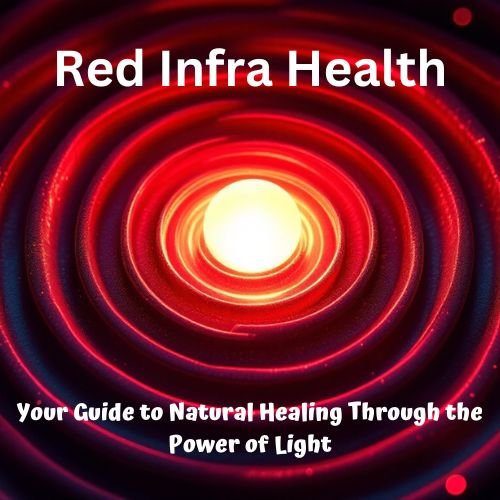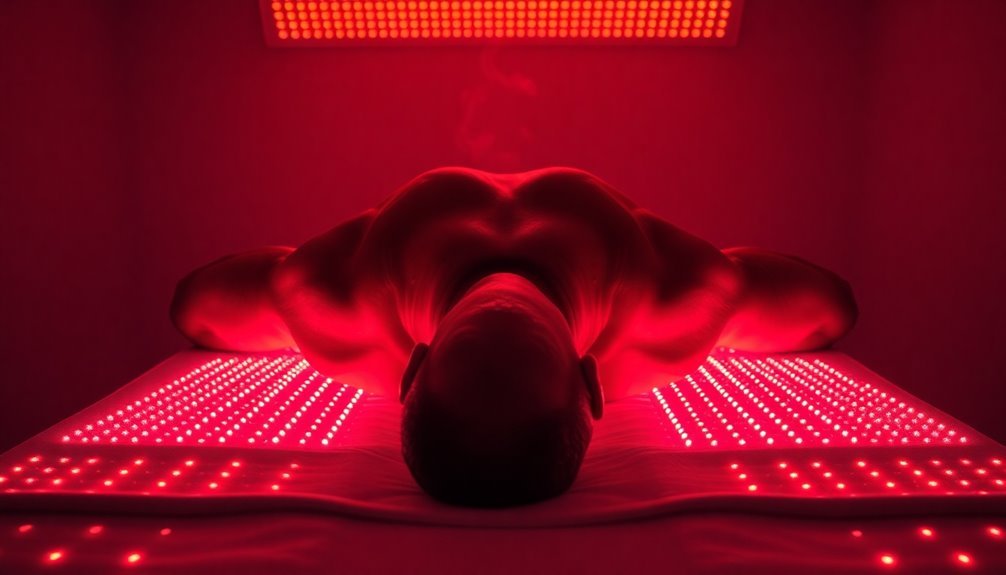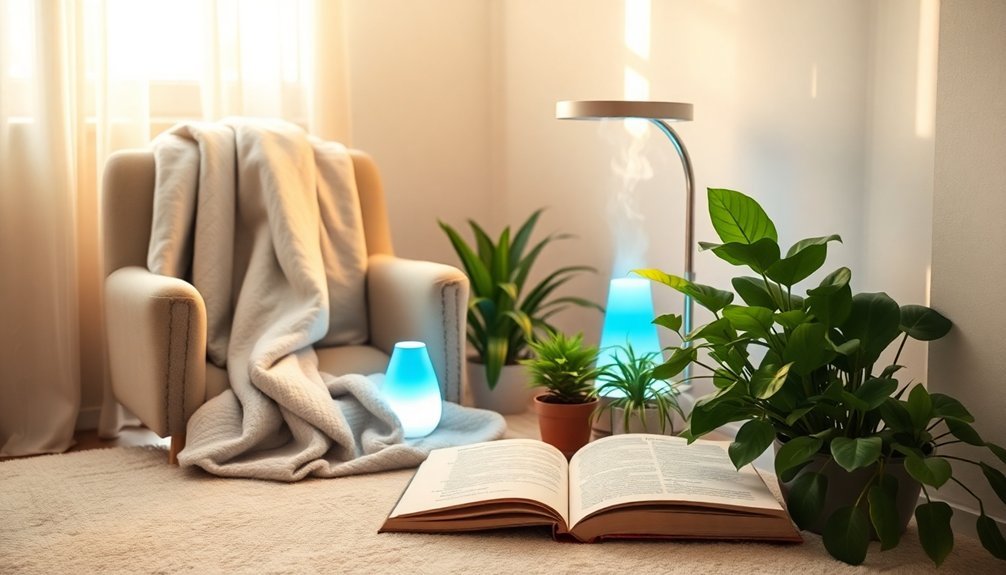The most effective wavelengths for post-exercise recovery include five key ranges that target different healing depths. You'll want 630-660nm for surface inflammation and initial healing, 640-700nm for ideal muscle repair and collagen synthesis, 810-850nm for deep tissue penetration and strength enhancement, 830nm specifically for muscle regeneration and oxidative stress reduction, and 700-1200nm for maximum ATP production and cellular energy boost. These wavelengths work together to speed up recovery, reduce soreness, and enhance performance. Understanding how to properly combine and time these wavelengths can substantially amplify your recovery results.
Understanding Red Light Recovery Benefits

Red light therapy consistently proves to be a game-changing recovery tool for athletes and fitness enthusiasts. When you expose your muscles to specific wavelengths of red light, you're triggering a powerful cellular response that accelerates your post-workout recovery.
The therapy targets light-sensitive molecules in your mitochondria, boosting ATP production and enhancing your cells' ability to regenerate. The wavelengths of 620-700 nanometers are particularly effective for optimal tissue penetration.
You'll experience faster muscle recovery through multiple mechanisms. The therapy reduces inflammation and muscle soreness by improving blood circulation throughout your treated areas.
It's particularly effective at stimulating your cellular functions, leading to increased production of growth factors that support tissue repair. If you're dealing with exercise-induced oxidative stress, red light therapy helps combat this while promoting better circulation to affected muscles.
What makes this therapy especially valuable is its versatility and non-invasive nature. You can use it before or after workouts to enhance your recovery speed and reduce downtime between training sessions.
The treatment works by stimulating your mitochondrial respiration cycle, which directly impacts your muscles' ability to repair and regenerate. This means you'll bounce back faster from intense workouts while experiencing less muscle fatigue.
Key Wavelengths for Post-Exercise Healing
When selecting wavelengths for post-exercise recovery, specific ranges between 630-1200 nm demonstrate the strongest therapeutic effects. You'll find the most beneficial results using wavelengths between 640-950 nm, as recommended by leading researchers for ideal muscle healing.
For surface-level recovery, you'll want to focus on the 630-660 nm range, which effectively reduces inflammation and promotes initial healing. At 630 nm, you'll experience improved muscle recovery and reduced soreness, while 660 nm enhances collagen synthesis for better tissue repair. The process works through photobiomodulation therapy, which stimulates cellular repair mechanisms.
If you're targeting deeper muscle tissue, concentrate on wavelengths between 810-850 nm. These penetrate further into your muscles, with 810 nm increasing strength and reducing inflammation, while 850 nm improves overall muscle function and reduces damage markers.
The 830 nm wavelength is particularly effective for enhancing muscle regeneration and reducing oxidative stress.
For thorough recovery, you might want to use devices that combine multiple wavelengths. The 700-1200 nm range offers deeper penetration for treating muscle damage, while the 830-1000 nm range shows promising results for ATP production and muscle regeneration.
Wavelength Penetration and Tissue Absorption

Through the complex layers of human tissue, light penetrates at varying depths depending on its wavelength. You'll find that shorter wavelengths (below 450 nm) only reach 200-1000 micrometers deep, while middle wavelengths (440-600 nm) can penetrate 1-2 millimeters.
For the deepest penetration, you'll want to look at longer wavelengths, particularly in the near-infrared window of 650-1350 nm, which can reach depths of 2-11 millimeters. Mie scattering from large collagen and elastin bundles becomes prominent in this range.
Your skin's layers respond differently to various wavelengths. The epidermis contains melanin that acts as a natural filter, with absorption rates varying among ethnic groups.
When light enters your tissue, it encounters different components like hemoglobin, water, and lipids, each with unique absorption properties. The background tissue absorption follows a specific formula: 7.84 *e*8 × λ -3.255 cm-1.
You'll get the most effective tissue penetration in the near-infrared window, where both absorption and scattering are minimized. This makes it particularly useful for targeting deeper muscle tissue, as the light can bypass surface layers more effectively while maintaining therapeutic power.
Optimal Timing and Treatment Duration
You'll want to use red light therapy 3-5 minutes before your workout to prevent injury and boost performance.
Red light therapy operates by enhancing ATP production in your muscle cells, maximizing cellular energy for better workout results.
Followed by a longer 10-15 minute session afterward for recovery.
For post-exercise treatment, target the specific muscle groups you've worked while also considering a full-body session if you've completed an intensive workout.
Your recovery timing can be optimized by scheduling red light therapy sessions 2-3 times per week, maintaining consistency for the best long-term results.
Pre-Session Warmup Guidelines
The science of pre-session warm-ups hinges on precision timing and carefully structured routines. You'll want to dedicate 10-30 minutes to your warm-up, gradually increasing your intensity from 50% to 90% of your maximum heart rate.
Keep your effort level moderate, around 4-5 on a 1-10 scale, to avoid premature fatigue. Blood flow increases significantly during this phase, enhancing muscle function and performance.
Structure your warm-up using the RAMP protocol, incorporating dynamic exercises after light jogging. If you're planning an intense workout, you'll need a longer, more thorough warm-up routine.
For compound exercises, start with lighter weights at 50-70% of your one-rep maximum. Include mobility exercises, like Joe Bennet's mobile meathead series, but don't overdo it.
If there's a break longer than 15 minutes between your warm-up and main activity, perform a 2-minute active re-warm-up with explosive movements. You can maintain muscle temperature by wearing heated garments after warming up.
Remember to tailor your routine to your specific workout needs, and avoid lengthy warm-ups that could lead to central fatigue. Consistency is key, but maintain flexibility in adapting your warm-up strategy based on the day's training demands.
Treatment Length By Need
Successful post-exercise recovery hinges on precise timing and tailored treatment durations. You'll need to act within the critical 4-hour window after exercise, with the first hour being most vital for maximum benefits. Your recovery protocol should start immediately post-workout to combat exercise-induced muscle damage and inflammation. Recent studies show that younger athletes respond better to cryotherapy treatments compared to those over 45 years old.
| Treatment Type | Duration | Timing | Impact |
|---|---|---|---|
| WBC (Cryotherapy) | 3 minutes | Within 1 hour | Rapid inflammation reduction |
| Cold Water Immersion | 10 minutes | First 2 hours | Deep muscle recovery |
| Heat Therapy | 15-30 minutes | After 24 hours | Enhanced circulation |
| Myofascial Release | 5-10 minutes | Immediately | Muscle tension relief |
Don't skip your post-workout nutrition – you've got a 30-60 minute window to maximize protein and carbohydrate intake for ideal muscle recovery. If you're using WBC, aim for temperatures between -110°C to -140°C for the full 3-minute session. For cold water immersion, maintain 15°C water temperature for the entire 10-minute treatment. Remember, your individual needs may vary based on training intensity, age, and sport-specific demands, so adjust these durations accordingly while maintaining the recommended timing windows.
Recovery Session Scheduling Tips
Planning your recovery sessions strategically can maximize their effectiveness and prevent overtraining. You'll want to start your recovery protocol within the critical 30-45 minute metabolic window after exercise, when your body is most receptive to nutrient uptake and repair processes.
If you wait longer than two hours, you'll substantially reduce the anabolic effects and compromise your recovery potential.
Hot and cold therapy can significantly accelerate muscle repair and reduce inflammation during recovery periods.
For ideal results, coordinate your recovery sessions with these workout intensity guidelines:
- High-intensity strength training sessions require 48-72 hours between workouts, with active recovery like gentle yoga or swimming on rest days.
- VO2 max intervals need longer recovery periods, and you should adjust your work-to-rest ratios based on exercise intensity.
- Endurance training can follow 2:1 or 1:1 work-to-rest ratios, but you'll need more recovery time due to accumulated fatigue.
Include 10-minute cool-down periods after your workouts using low-intensity activities like walking or cycling.
Consider your age when planning recovery timing, as younger athletes typically bounce back faster than older ones.
Limit high-intensity workouts to twice weekly, scheduling lighter sessions between them to maintain progress while allowing adequate recovery.
Wavelength Combinations for Maximum Results

You'll achieve peak post-workout recovery by combining red light wavelengths (630, 660 nm) with near-infrared wavelengths (810, 830, 850 nm) in your treatment protocol.
Your recovery sessions become more effective when you time these dual-wavelength treatments immediately after exercise, targeting both surface tissues and deep muscle groups simultaneously.
The synergistic effects of using both spectrums can accelerate your muscle repair while reducing inflammation, making it a more powerful approach than single-wavelength treatments alone. The zero EMF exposure from quality red light therapy devices ensures safe, continuous use during your recovery routine.
Synergistic Red-NIR Therapy Protocols
The most powerful recovery benefits emerge when combining specific red and near-infrared wavelengths in a strategic protocol. You'll achieve the best results by combining red light (630-670 nm) with NIR wavelengths (810-890 nm), as this combination penetrates both superficial and deep tissue layers simultaneously. This dual-wavelength approach accelerates muscle recovery while reducing inflammation and enhancing overall performance.
To maximize your recovery benefits, follow these key protocol elements:
- Schedule 3-4 sessions per week, spacing them evenly between workout days to maintain consistent recovery support.
- Position yourself 6-12 inches from the light source, adjusting the distance based on the device's power output and your comfort level.
- Start with 10-minute sessions and gradually increase duration based on your body's response and recovery needs.
You'll want to adjust your protocol's intensity and duration based on your specific recovery requirements. Pre-workout sessions can focus more on performance enhancement, while post-workout treatments should emphasize inflammation reduction and tissue repair.
Remember to maintain consistency with your sessions, as regular application yields the best long-term results for muscle recovery and athletic performance.
Dual-Wave Performance Enhancement
Through strategic wavelength combinations, dual-wave performance enhancement takes recovery to the next level by targeting multiple tissue depths simultaneously. You'll achieve ideal results by combining specific wavelengths that work synergistically, such as pairing 660nm with 850nm for thorough tissue penetration from surface to deep layers.
Research shows that multi-wavelength approaches deliver superior outcomes compared to single-wavelength treatments. When you're looking to maximize your recovery, consider devices that offer the following proven wavelength combinations:
| Wavelength Pair | Primary Benefits | Tissue Depth |
|---|---|---|
| 660nm + 850nm | Recovery & Inflammation | Surface to Deep |
| 610nm + 630nm | Pain & Skin Health | Superficial |
| 810nm + 830nm | NO Release & Pain Relief | Deep |
| 630nm + 810nm | Circulation & Healing | Mixed |
| 660nm + 810nm | Cellular Function | Mixed |
To maximize the effectiveness of dual-wave therapy, you'll want to guarantee proper dosing and intensity levels for each wavelength. The total energy delivery during your treatment sessions becomes more potent when multiple wavelengths work together, activating different biological pathways and photoacceptors throughout your tissue layers.
Strategic Wavelength Timing Windows
Building on the power of dual-wave treatments, strategic timing windows can dramatically amplify your recovery results. You'll achieve maximum benefits by applying red (630-700 nm) and near-infrared (700-1200 nm) wavelengths within specific timeframes around your workout sessions. This dual-spectrum approach allows for both surface-level and deep tissue penetration, maximizing cellular regeneration and reducing inflammation.
To enhance your recovery timeline, follow these key windows:
- Pre-workout: Apply light therapy 5-10 minutes per muscle group at 6-12 inches distance, up to 6 hours before exercise to prime your muscles and boost ATP production.
- Post-workout: Extend treatment to 10-20 minutes per muscle group immediately after exercise when tissue is most receptive to repair signals.
- Recovery phase: Schedule 15-30 minute sessions 3-4 times weekly for continued healing, with effects lasting up to 54 hours post-treatment.
You'll want to maintain consistent distance and intensity throughout each session while adjusting frequency based on your training intensity. For intensive routines, daily treatments prove most effective, while general maintenance requires only 3-4 sessions per week.
Monitor your progress and adjust timing as needed to match your body's response.
Recovery Protocol Best Practices
Successful post-exercise recovery demands a well-structured protocol that combines proper nutrition, active recovery techniques, and adequate rest periods.
You'll want to consume 20g of protein and carbohydrates within 30 minutes of your workout to restore glycogen stores and prevent muscle breakdown. Stay hydrated throughout the day and replenish lost electrolytes to maintain proper fluid balance.
Incorporate active recovery techniques like gentle stretching or slow walking immediately after exercise. You can enhance recovery by using compression garments, taking 10-minute ice baths, or utilizing foam rolling to reduce muscle tension.
Don't skip your cool-down routine, as it prevents blood pooling and reduces muscle soreness.
Make sleep a priority by getting 7-9 hours each night and maintaining a consistent sleep schedule. Create a comfortable sleep environment and practice stress management techniques like meditation to optimize your recovery.
Remember to plan your training sessions wisely, allowing adequate rest between workouts targeting the same muscle groups. If you're considering supplements, BCAAs or tart cherry juice can support your recovery efforts, but they shouldn't replace proper nutrition and rest.
Scientific Evidence Behind Light Therapy

Light therapy has emerged as a powerful tool for post-exercise recovery, backed by extensive scientific research. Systematic reviews and meta-analyses consistently demonstrate that both Low-Level Light Therapy (LLLT) and Light-Emitting Diode Therapy (LEDT) substantially improve muscular performance and accelerate recovery times.
You'll find compelling evidence showing that light therapy outperforms traditional recovery methods, including ice baths, in reducing muscle damage markers.
The scientific data reveals three key benefits that make light therapy particularly effective:
- Enhanced ATP production within cells, providing more energy for tissue repair and regeneration
- Reduced inflammation through decreased production of pro-inflammatory cytokines, leading to faster recovery
- Improved blood circulation, delivering essential nutrients and oxygen while removing metabolic waste
Studies focusing on tendinopathy have shown remarkable improvements in pain reduction and functional recovery when using specific wavelengths. Research indicates that red light (630-700 nm) and near-infrared light (700-1200 nm) penetrate tissue most effectively, stimulating cellular repair mechanisms.
You'll achieve the best results by applying these wavelengths both before exercise to boost performance and after exercise to accelerate recovery.
Future of Recovery Light Technology
The rapid evolution of recovery light technology points to an exciting future in athletic rehabilitation and wellness. You'll soon experience more personalized treatments through smart devices that integrate with your smartphone, allowing you to adjust intensity, duration, and wavelength based on your specific recovery needs.
| Innovation | Benefit | Impact |
|---|---|---|
| AI Integration | Personalized protocols | Optimized recovery times |
| Smart Sensors | Real-time adjustments | Enhanced treatment efficacy |
| Wearable Tech | Continuous treatment | Greater convenience |
| High-density LEDs | Deep tissue penetration | Faster muscle recovery |
| Full-body Panels | Extensive coverage | Complete rehabilitation |
The next generation of recovery light devices will combine LED technology with artificial intelligence to create highly effective, targeted treatments. You'll benefit from more portable and user-friendly devices that deliver consistent, concentrated doses of red light therapy. These advancements aren't just about convenience – they're about maximizing your recovery potential through precise, scientifically-backed methods. As research continues to expand, you'll see integration with other therapeutic approaches, including physical therapy and regenerative medicine, creating a more holistic approach to athletic recovery and performance enhancement.
Frequently Asked Questions
Can Red Light Therapy Help With Muscle Strains During Competition Seasons?
Yes, you'll find red light therapy helpful during competition seasons. It'll reduce inflammation, speed up healing, and prevent muscle fatigue. You can use it before and after games to maintain peak performance.
Does Taking Supplements Affect the Effectiveness of Light Therapy Treatments?
While you can safely take supplements during light therapy, there's limited research on how they interact. Current studies don't show clear evidence that supplements either enhance or reduce light therapy's effectiveness.
Are There Any Skin Conditions That Make Light Therapy Unsuitable?
Yes, you shouldn't use light therapy if you have lupus, xeroderma pigmentosum, porphyria, or photosensitive conditions. It's also risky if you've had skin cancer or have severe eczema, especially in young children.
Can You Combine Light Therapy With Ice Baths or Heat Therapy?
You can combine light therapy with ice baths or heat therapy, but you'll need to space them out. Use light therapy first, then wait 30 minutes before using ice or heat for maximum benefits.
Should You Avoid Light Therapy During Certain Phases of Menstruation?
You'll want to adjust your light therapy during the late luteal phase, but you don't need to avoid it entirely. Just make sure you're using appropriate wavelengths and timing to match your cycle's specific needs.
In Summary
You're now equipped to optimize your post-exercise recovery using the most effective wavelengths of red and near-infrared light. By targeting the 630-850nm range, particularly the proven 660nm and 850nm wavelengths, you'll accelerate muscle repair and reduce inflammation. Remember to apply light therapy within 2 hours post-workout for 10-20 minutes, and you'll notice improved recovery times and reduced muscle soreness.





Leave a Reply